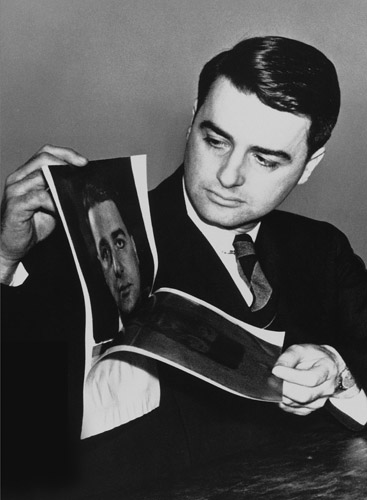Edwin Land and the Birth of Instant Photography
Edwin Land and the Birth of Instant Photography
Sammi Bradley, Digital Communications Coordinator, Optica
Photography can show us who we are, and make permanent the ephemeral stories carried by light. From the two-tone heliography to modern smartphones, the story of photography is a story of innovation. It’s the story of optics
Join us in celebrating World Photography Week and reflect on a monumental photography development: Optica Honorary Member Edwin Land’s creation of the instant photo.
Inventor, scientist and entrepreneur Edwin Land was first to develop inexpensive polarizing filters. Rather than grow a single, large crystal of a polarizing substance, Land created a film with millions of micron-scale polarizing crystals, all coaxed into alignment with each other. This breakthrough, which he patented in 1933, led to his development of the polaroid film. He established the Polaroid Corporation together with his Harvard Physics Professor George Wheelwright III to commercialize his invention.
In 1943, Land made another breakthrough, inspired by his daughter. She asked him why she couldn’t see photos right after they were taken. Thus Land set out to develop instant photography. In a radical departure from traditional photography, he created a tool with both a negative film and a positive receiving sheet. When the camera’s shutter opened, light entered to hit the highly sensitive film, leaving behind an image of the scene. The photographer only had to wait about a minute before peeling apart the negative and positive layers of film to reveal a fully developed photograph.
The result: the invention of the first instant camera, the Land Camera.
Land demonstrated his new camera and the instant photography process at the 1947 Optica (then OSA) Winter Meeting. In 1948, Polaroid launched the Land Camera on the market, with 57 units for sale. They sold out on the first day.

Land shows an early instant photograph at the 1947 OSA Winter Meeting
Land’s next development took instant photos from black and white to full color.
Under Land's leadership, Polaroid chemists developed new compounds – called dye developers – over the course of five thousand tests to act as both dye and developer molecules for proper color formation of the photograph. After years of testing, Polaroid successfully debuted color instant film in 1963.
Land retired as chairman of Polaroid in 1980, going on to found the Rowland Institute for Science at Harvard University. Despite dropping out of college his freshman year, Land received numerous honorary degrees from institutions such as Harvard, Yale and Columbia. His accolades include the Presidential Medal of Freedom for his optics research, the Optica Frederic Ives Medal and the Cresson, Potts and Vermilye Medals from the Franklin Institute. Land was inducted into the National Inventors Hall of Fame and received the National Medal of Technology. In total, he held 535 U.S. patents.
To celebrate his life and legacy as a pioneer in optics, Optica and the Society for Imaging Science and Technology award the Edwin H. Land Medal to members of the scientific community who embody his insatiable scientific intensity and curiosity in optics and imaging.
